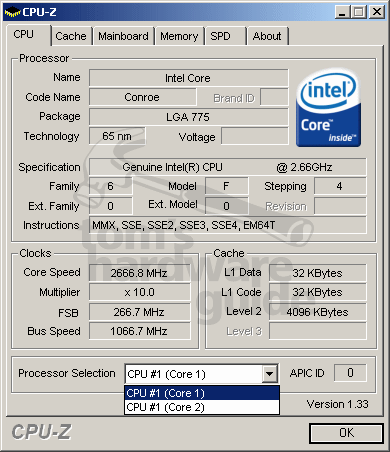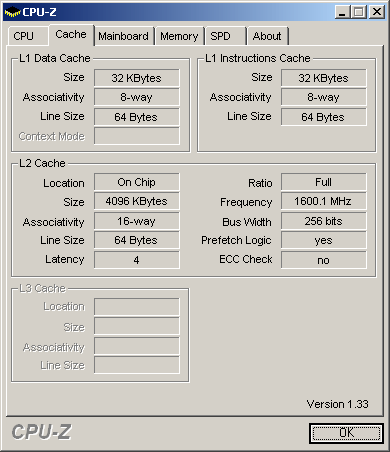First Benchmarks: Conroe vs. FX-62
First Official Benchmarks, Continued

The Conroe test system features a 2.66 GHz Conroe dual core processor with a 266 MHz Front Side Bus (FSB1066 at quad data rate). Each core has a 64 kB L1 cache, divided into a data cache and instruction cache of 32 kB each. The processor also includes a whopping 4 MB of L2 Cache, shared by the cores.

The Conroe processor is clocked at 2.66 MHz, and is built using Intel's latest 65 nm process technology.
Previous generations of dual core processors from both Intel and AMD have consisted of two individual processors merged onto a single die or placed into a package. In both cases, these were tied together using an internal interconnect: Intel used the FSB, while AMD utilized Hyper Transport. Each of these CPU cores had its own dedicated L2 cache, and could only access the L2 cache of the other CPU core by going over this interconnect.
The Conroe architecture departs from these "separate but equal" designs by incorporating separate CPU processor cores that share a common L2 cache. Depending on the load on each processor core, portions of the cache are allocated to one or the other, using Intel's Advanced Smart Cache technology. If one single-threaded application runs on one of the cores - which is still the case of the majority of programs today - the active core is granted exclusive access to the entire 4 MB L2 cache. This is one reason why this processor is extraordinarily fast if you do a clock-to-clock comparison with the Pentium D. When two applications run in tandem, where one application only requires a small amount of cache space to run, the other program can grab the entire remaining L2 cache space for its own use. Intel had already made clear that it could manage shared cache in this way with the introduction of its Core Duo mobile processors (code-named Yonah).

Each core has up to 4 MB of L2 cache space at its disposal, thanks to Intel's dynamic cache allocation scheme.
Stay on the Cutting Edge
Join the experts who read Tom's Hardware for the inside track on enthusiast PC tech news — and have for over 25 years. We'll send breaking news and in-depth reviews of CPUs, GPUs, AI, maker hardware and more straight to your inbox.
Current page: First Official Benchmarks, Continued
Prev Page Intel's Conroe Takes On The AMD Athlon 64 FX-62: First Official Benchmarks Next Page SpeedStepTom's Hardware's dedicated news crew consists of both freelancers and staff with decades of experience reporting on the latest developments in CPUs, GPUs, super computing, Raspberry Pis and more.
Most Popular


